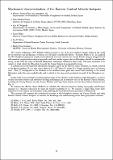Por favor, use este identificador para citar o enlazar a este item:
http://hdl.handle.net/10261/164884COMPARTIR / EXPORTAR:
 SHARE
BASE SHARE
BASE
|
|
| Visualizar otros formatos: MARC | Dublin Core | RDF | ORE | MODS | METS | DIDL | DATACITE | |

| Título: | Mechanical characterization of the Eastern Central Atlantic hotspots |
Autor: | Jiménez Díaz, Alberto CSIC ORCID ; Sánchez-Pastor, Pilar CSIC ORCID ; Negredo, Ana M. CSIC ORCID; Fullea, J. CSIC ORCID; Kirby, Jon F.; Pérez-Gussinyé, M. | Fecha de publicación: | 28-ago-2017 | Citación: | XV International Workshop on Modelling of Mantle and Lithosphere Dynamics (2017) | Resumen: | The Canary archipelago (NW Atlantic African margin) is one of the best studied volcanic chains in the world yet its structure and geodynamic evolution are still under considerable debate. Recently, Fullea et al. [1] analysed the 3D lithospheric-uppermost mantle thermochemical structure beneath the Canary Islands using an integrated and self-consistent geophysicalpetrological approach, and their results suggest that its lithosphere should be mechanically strong, in line with the range of thermal lithospheric thicknesses obtained in that study. This issue motivates us to explore to what extent the lithosphere beneath the Canary Islands is mechanically strong. A useful proxy for the long-term lithospheric strength is given by the effective elastic thickness, Te, which is related to the exural rigidity, D, of a thin elastic plate by D = ET3 e =12(12), where E is Youngs modulus and E is Poissons ratio. Thus, Te corresponds to the thickness of an idealized elastic plate that would bend similarly to the actual lithosphere under the same applied loads, and is related to the integrated mechanical strength of the lithosphere (e.g. [2]). In this study we present high-resolution regional maps of the effective elastic thickness of the lithosphere, as well as of their associated surface and subsurface loading mechanisms, for an extensive area of the Eastern Central Atlantic, including the Canary Islands, but also Azores, Madeira and Cape Verde islands, and the Great Meteor Seamount (see Fig. 1). To estimate the effective elastic thickness we calculate the coherence function relating topography and Bouguer anomaly (i.e. Bouguer coherence) by using the wavelet transform [3, 4]. We consider a simple thin elastic plate subjected to both surface and subsurface loads, following the load deconvolution procedure of Forsyth [5]. This analysis will constrain the mechanical structure of the lithosphere beneath the Canary Islands and other | URI: | http://hdl.handle.net/10261/164884 |
| Aparece en las colecciones: | (Geo3Bcn) Comunicaciones congresos (IGEO) Comunicaciones congresos |
Ficheros en este ítem:
| Fichero | Descripción | Tamaño | Formato | |
|---|---|---|---|---|
| Sanchez-Pastor_book_of_abstracts_XV International workshop on modelling of mantle and lithospheric dynamics (Nethermod).pdf | 32,54 kB | Adobe PDF |  Visualizar/Abrir |
CORE Recommender
Page view(s)
235
checked on 22-abr-2024
Download(s)
77
checked on 22-abr-2024
Google ScholarTM
Check
NOTA: Los ítems de Digital.CSIC están protegidos por copyright, con todos los derechos reservados, a menos que se indique lo contrario.
